Looking to refresh your call centre’s opening spiel with customer service greetings that create a great first impression?
A warm, professional greeting sets the tone for the entire conversation – so we’ve gathered the best real-life examples to help you get it just right!
10 Examples of an Opening Spiel for Customer Service
With 59% of professionals saying their contact centre is primarily voice, it’s important that agents are trained to properly greet customers and get every conversation off to the best possible start.
To help, we’ve personally called up agents at some of the biggest brands to find out how they greet their customers to share these real-life examples of greetings with you:
1. “Welcome to [Lego] Customer Service. My Name is [INSERT NAME]. How Can I Help You?”
This pleasant phone greeting to a customer, used by Lego, offers a unique opening in “welcome to…” leaning into the call being a positive experience, as opposed to a simple transaction.
It’s also a bit more conversational and informal in using the phrase “how can I help you?” as an alternative to the more formal “how may I help you today?”
2. “Good Afternoon! You’re Through to [John Lewis]. My Name is [INSERT NAME]. How May I Help You Today?”
Another example for greeting customers is this jolly opening spiel from John Lewis uses three personal pronouns: “you”, “my” and “I” as a method to help establish a personal connection.
3. “Good Afternoon. You’re Speaking to [INSERT NAME]. How May I Help You?”
This phrase – the greeting used by a customer service agent at DPD – uses two personal pronouns “I” and “you”, which help to demonstrate that the agent wants to personally help the caller – as an individual.
4. “Good Afternoon! [Visit Wales], [INSERT NAME] Speaking. How May I Help You?”
As is the case in some of the other examples on this list, the agent at Visit Wales opens with a traditional way of greeting customers, by introducing the company and themselves, before asking the customer how they can help. This is a popular format for any welcome call.
5. “Hi! You’re Through to [UCAS], How Can I Help You?”
Beginning with “hi”, this call centre greeting stands out as being more relaxed and informal.
Likely a deliberate choice from the UCAS team, due to their customer base being comprised mainly of students, this sets a more relaxed tone.
When greeting customers, the use of the word “hi” also helps the conversation to sound more natural and less scripted.
For more advice on developing call centre scripts, read this article: How to Develop the Best Contact Centre Script
6. “Hello, Good Afternoon. [INSERT NAME] From [Autoglass] Speaking. How Can I Help?”
This one is more conversational and wordier, with two separate openings in the greeting – “hello” and “good afternoon” – as well as stating the obvious of “speaking”, but these additional words go a long way in helping the agent at Autoglass appear more human and less scripted/ robotic from the very start of the call.
7. “[British Airways]! How Can I Help You?”
This is British Airways’ customer service greeting. If you’re looking for a short and sweet call centre greeting that still showcases great telephone etiquette, here it is!
No doubt, this is a concise option for those looking for quick wins on reducing their Average Handling Time (AHT).
8. “Good Afternoon! [DW Sports Online], How Can I Help?”
In DW Sports Online’s customer service greeting, there is no introduction from the agent – only the company. Whilst this helps to keep it short, some would say the lack of personalisation here could compromise the agent building rapport with the customer.
9. “Good Afternoon! You are Through to [Lidl] Customer Service. Can I Take Your name Please?”
In this example from Lidl, it’s interesting to note that the agent asks for the customer’s name – likely as part of a security process – before making time to introduce themselves.
Whilst this example for greeting customers cuts straight to the chase of resolving the issue in hand, it could also benefit from being personalised before moving on to ask for the customer’s information.
10. “Good Afternoon! Welcome to [DFS] Customer Service. My Name is [INSERT NAME]. Just to Let You Know Our Calls May be Recorded.”
This customer service greeting from DFS follows the widely used format of “hello, welcome, my name is…”, but also prioritises telling the customer the call may be recorded.
Whilst agents are likely tasked with telling customers this, its place in the opening greeting feels a little hurried and shoe-horned in. It could perhaps be better placed within the initial conversation a bit further into the call.
To find out how your greeting can determine the success of the rest of the conversation, read our article: Customer Psychology: The Key to Better Contact Centre Conversations
Printable – 10 Customer Service Greeting Examples
Do you want a copy of this to share with your team?
Get your free download of 10 Customer Service Greeting Examples now:
What Makes a Good Call Opening for Customer Service?
First impressions matter! So what makes a good call centre greeting?
Here are the golden rules on the most effective ways to greet customers:
Don’t Be Too Formal
Many customers prefer contact centre agents to use the opening “hi” instead of “hello”. Also, not everyone likes being addressed by their first name, without being asked first.
People tend to prefer agents to keep the conversation informal, maybe so they feel as if the interaction is more natural, hinting that agents should not be robotic in their use of scripts.
Mirror the Customer
As Neil Martin of The First Word spoke about during this webinar on ‘How to Give the Wow Factor on Email and Live Chat’, agents should take their cue from the customer.
For example, if the customer signs off with their first name, you can use their first name to address them. The same can apply to phone calls and how the customer introduces themselves.
Ask “How CAN I Help You?”
In the theme of keeping a greeting informal, more of our survey respondents preferred a greeting to include the question “how can I help you?” (52.50%), as opposed to the slightly more formal proposition “how may I help?” (47.50%).
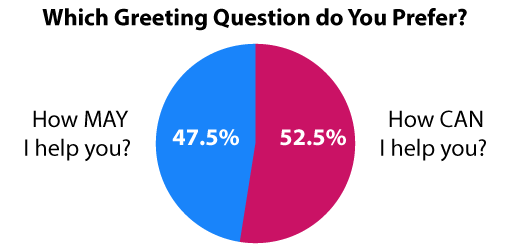
However, this was only by a very small margin, and it is important to remember that a more formal greeting may be more appealing for up-market brands.
Other questions that our readers have proposed using in a greeting, include:
- “How may I be of service?”
- “What can I assist you with?”
- “What may I assist you with?”
Ask Your Agents to Introduce Themselves
As seen in the below poll, survey participants overwhelmingly believed that an advisor should introduce themselves in their greeting. In fact, 94.19% asserted that this was something that an advisor should do.
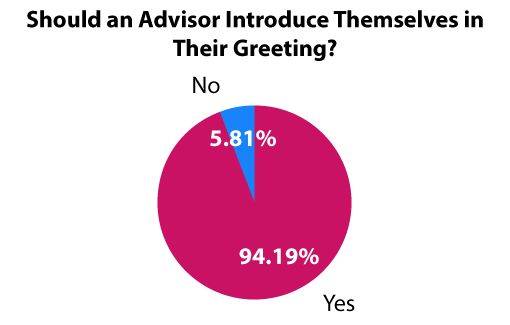

Yet Phil Anderson, CEO at The Forum, offers a different opinion:
“If you want a customer to remember your name, don’t include it in the opening message as this is likely to be too much information. Ask for their name/reference then introduce yourself; the customer is much more likely to remember you that way.”
Consider Using a Play on Words
A creative greeting can make your brand more memorable. If your company name allows, try incorporating a clever play on words.
For example, one service company uses:
“Thank you for calling Allgood Plumbing, Electric, Heating & Cooling. This is Tiffany. How can I take Allgood care of you today?”
It’s slightly longer but adds a fun, personal touch that customers appreciate. Just keep it clear, professional, and easy to understand.
Contributed by: Tiffany
Don’t Apologise for the Wait
Instead of starting with an apology like “sorry for the wait,” try a more positive approach, such as “thank you for your patience.” While it may seem like a small change, it helps set a better tone for the conversation.
Apologising right away can make the interaction feel negative from the start, even if the wait time was unavoidable. On the other hand, expressing appreciation acknowledges the delay while keeping the focus on moving forward with a helpful and professional attitude.
Contributed by: Alex
Don’t Repeat What’s on the IVR
If your IVR (Interactive Voice Response) system already states the company name, there’s no need for agents to repeat it when answering the call. Instead, they can jump straight into a more engaging and efficient greeting, such as “Good day, you’re speaking with [INSERT NAME]. How can I help you?”
This approach reduces unnecessary repetition and making the interaction feel more natural. It also allows the customer to quickly focus on their reason for calling, improving the overall experience.
Contributed by: Debby
Don’t Just Rely on Words
A well-crafted greeting is important, but how it’s delivered matters just as much as what is said. Even the most polished script will fall flat if spoken in a monotone or rushed manner. Agents should focus on tone, clarity, and warmth to make their greeting feel genuine and engaging.
A friendly, confident voice can immediately set a positive tone for the conversation, making customers feel valued and at ease. Smiling while speaking – even over the phone – can also help convey warmth and approachability.
Get Your Agents Involved
When it comes to crafting the perfect greeting, don’t overlook the valuable insights your agents can offer. After all, they are the ones interacting with customers every day and have a deep understanding of what resonates best.
By involving agents in the process, you’re not only ensuring the greeting sounds natural, but you’re also allowing them to share what works in real, everyday scenarios.
Encourage them to share their feedback on what types of phrases or tones seem to build rapport most effectively. They can also spot areas for improvement based on customer reactions.
Don’t Waffle
In today’s fast-paced world, customers appreciate efficiency, especially when they’re reaching out for assistance.
While a friendly tone is important, avoid unnecessary fillers or long-winded introductions that might make the call feel more drawn out than it needs to be. Agents should focus on delivering a concise, clear greeting that quickly transitions into resolving the customer’s issue.
A good rule of thumb is to ask yourself: “What do I absolutely need to say right now?” Keep the greeting friendly but brief, and always prioritize the customer’s time.
For example, instead of a long-winded “Thank you for calling, I hope you’re having a good day,” try something like “Good afternoon, this is [Agent’s Name] from [Company Name], how can I assist you today?”
If you want more ways to improve customer service interactions, read these articles next:
- The Top 12 Acknowledgement Statements
- Best Tips, Phrases and Words to Use for Building Rapport
- The Right Words and Phrases to Use on a Sales Call
Author: Megan Jones
Reviewed by: Robyn Coppell
Published On: 19th Jul 2017 - Last modified: 14th Aug 2025
Read more about - Skills, Editor's Picks, Free Downloads, Language, Phil Anderson, Positive Words, Rapport, Skill Development, The Forum




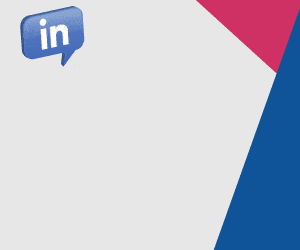

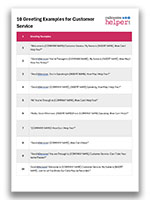


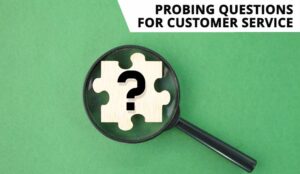
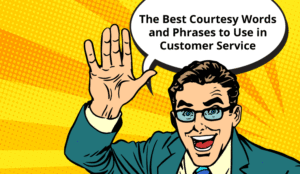

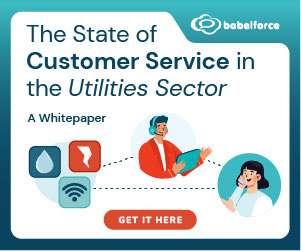




Great opening build great conversations .. rapport building is so important in those initial moments.